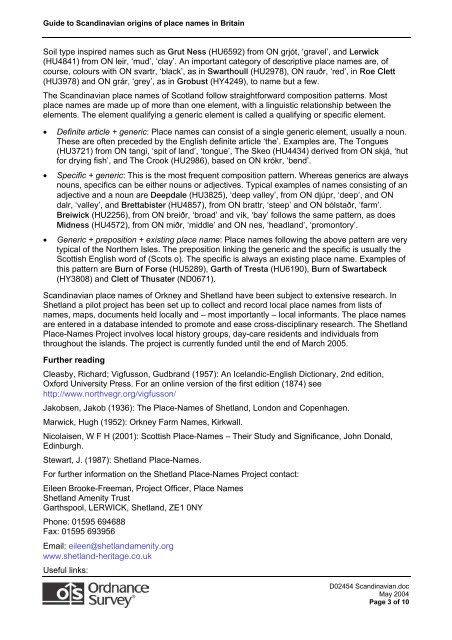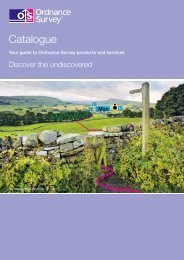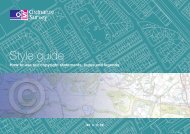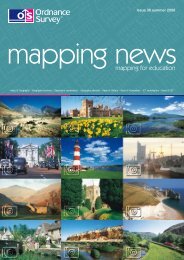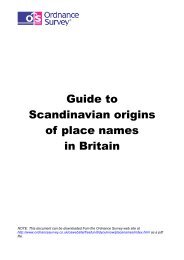Guide to Scandinavian origins of place names in ... - Ordnance Survey
Guide to Scandinavian origins of place names in ... - Ordnance Survey
Guide to Scandinavian origins of place names in ... - Ordnance Survey
Create successful ePaper yourself
Turn your PDF publications into a flip-book with our unique Google optimized e-Paper software.
<strong>Guide</strong> <strong>to</strong> <strong>Scand<strong>in</strong>avian</strong> <strong>orig<strong>in</strong>s</strong> <strong>of</strong> <strong>place</strong> <strong>names</strong> <strong>in</strong> Brita<strong>in</strong><br />
Soil type <strong>in</strong>spired <strong>names</strong> such as Grut Ness (HU6592) from ON grjót, ‘gravel’, and Lerwick<br />
(HU4841) from ON leir, ‘mud’, ‘clay’. An important category <strong>of</strong> descriptive <strong>place</strong> <strong>names</strong> are, <strong>of</strong><br />
course, colours with ON svartr, ‘black’, as <strong>in</strong> Swarthoull (HU2978), ON rauðr, ‘red’, <strong>in</strong> Roe Clett<br />
(HU3978) and ON grár, ‘grey’, as <strong>in</strong> Grobust (HY4249), <strong>to</strong> name but a few.<br />
The <strong>Scand<strong>in</strong>avian</strong> <strong>place</strong> <strong>names</strong> <strong>of</strong> Scotland follow straightforward composition patterns. Most<br />
<strong>place</strong> <strong>names</strong> are made up <strong>of</strong> more than one element, with a l<strong>in</strong>guistic relationship between the<br />
elements. The element qualify<strong>in</strong>g a generic element is called a qualify<strong>in</strong>g or specific element.<br />
• Def<strong>in</strong>ite article + generic: Place <strong>names</strong> can consist <strong>of</strong> a s<strong>in</strong>gle generic element, usually a noun.<br />
These are <strong>of</strong>ten preceded by the English def<strong>in</strong>ite article ‘the’. Examples are, The Tongues<br />
(HU3721) from ON tangi, ‘spit <strong>of</strong> land’, ‘<strong>to</strong>ngue’, The Skeo (HU4434) derived from ON skjá, ‘hut<br />
for dry<strong>in</strong>g fish’, and The Crook (HU2986), based on ON krókr, ‘bend’.<br />
• Specific + generic: This is the most frequent composition pattern. Whereas generics are always<br />
nouns, specifics can be either nouns or adjectives. Typical examples <strong>of</strong> <strong>names</strong> consist<strong>in</strong>g <strong>of</strong> an<br />
adjective and a noun are Deepdale (HU3825), ‘deep valley’, from ON djúpr, ‘deep’, and ON<br />
dalr, ‘valley’, and Brettabister (HU4857), from ON brattr, ‘steep’ and ON bólstaðr, ‘farm’.<br />
Breiwick (HU2256), from ON breiðr, ‘broad’ and vík, ‘bay’ follows the same pattern, as does<br />
Midness (HU4572), from ON miðr, ‘middle’ and ON nes, ‘headland’, ‘promon<strong>to</strong>ry’.<br />
• Generic + preposition + exist<strong>in</strong>g <strong>place</strong> name: Place <strong>names</strong> follow<strong>in</strong>g the above pattern are very<br />
typical <strong>of</strong> the Northern Isles. The preposition l<strong>in</strong>k<strong>in</strong>g the generic and the specific is usually the<br />
Scottish English word <strong>of</strong> (Scots o). The specific is always an exist<strong>in</strong>g <strong>place</strong> name. Examples <strong>of</strong><br />
this pattern are Burn <strong>of</strong> Forse (HU5289), Garth <strong>of</strong> Tresta (HU6190), Burn <strong>of</strong> Swartabeck<br />
(HY3808) and Clett <strong>of</strong> Thusater (ND0671).<br />
<strong>Scand<strong>in</strong>avian</strong> <strong>place</strong> <strong>names</strong> <strong>of</strong> Orkney and Shetland have been subject <strong>to</strong> extensive research. In<br />
Shetland a pilot project has been set up <strong>to</strong> collect and record local <strong>place</strong> <strong>names</strong> from lists <strong>of</strong><br />
<strong>names</strong>, maps, documents held locally and – most importantly – local <strong>in</strong>formants. The <strong>place</strong> <strong>names</strong><br />
are entered <strong>in</strong> a database <strong>in</strong>tended <strong>to</strong> promote and ease cross-discipl<strong>in</strong>ary research. The Shetland<br />
Place-Names Project <strong>in</strong>volves local his<strong>to</strong>ry groups, day-care residents and <strong>in</strong>dividuals from<br />
throughout the islands. The project is currently funded until the end <strong>of</strong> March 2005.<br />
Further read<strong>in</strong>g<br />
Cleasby, Richard; Vigfusson, Gudbrand (1957): An Icelandic-English Dictionary, 2nd edition,<br />
Oxford University Press. For an onl<strong>in</strong>e version <strong>of</strong> the first edition (1874) see<br />
http://www.northvegr.org/vigfusson/<br />
Jakobsen, Jakob (1936): The Place-Names <strong>of</strong> Shetland, London and Copenhagen.<br />
Marwick, Hugh (1952): Orkney Farm Names, Kirkwall.<br />
Nicolaisen, W F H (2001): Scottish Place-Names – Their Study and Significance, John Donald,<br />
Ed<strong>in</strong>burgh.<br />
Stewart, J. (1987): Shetland Place-Names.<br />
For further <strong>in</strong>formation on the Shetland Place-Names Project contact:<br />
Eileen Brooke-Freeman, Project Officer, Place Names<br />
Shetland Amenity Trust<br />
Garthspool, LERWICK, Shetland, ZE1 0NY<br />
Phone: 01595 694688<br />
Fax: 01595 693956<br />
Email: eileen@shetlandamenity.org<br />
www.shetland-heritage.co.uk<br />
Useful l<strong>in</strong>ks:<br />
D02454 <strong>Scand<strong>in</strong>avian</strong>.doc<br />
May 2004<br />
Page 3 <strong>of</strong> 10


